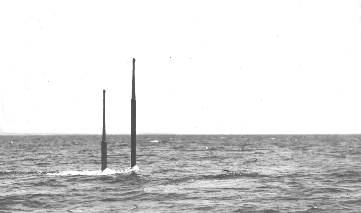PERISCOPES The
essential function of the periscope is to give an officer conning a submarine
a view of the surrounding horizon while the vessel is submerged. The
essential function of the periscope is to give an officer conning a submarine
a view of the surrounding horizon while the vessel is submerged.
Although simple in principle, the periscope is actually a very complicated piece of apparatus. Essentially, a periscope consists of a vertical tube with a head prism inclined to the horizon at a 45 degree angle, a reducing telescope to cover a wide field, and at the bottom of the tube, an enlarging telescope and a lower prism facing the head prism and parallel to and below it. The objectives of the two telescopes face each other. Originally the periscopes aboard Pampanito were raised and lowered my cables powered by electric motors. Near the end of the war this was switched to hydraulic power. The periscopes are about forty feet long and when lowered rest on rubber bumpers at the bottom of the pressure hull. When they are raised they pass through packing to prevent leaking and several brass bearings in the support housings, or shears. They are filled with dry nitrogen to prevent fogging. The periscopes were also used as part of the fire control system and could be used to determine the range and bearing of a target. The after scope, or attack scope, is fitted with an optical range finder to determine the range to the target. The forward, or general observation scope, is fitted with ST radar and provided very accurate target ranges.
|

